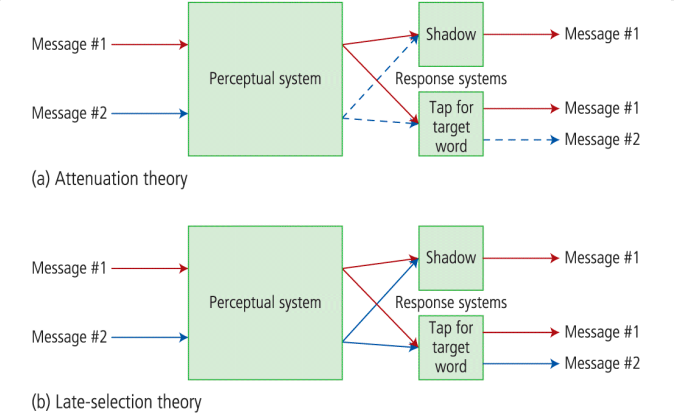C3 Attention and performance
1/23
There's no tags or description
Looks like no tags are added yet.
Name | Mastery | Learn | Test | Matching | Spaced |
|---|
No study sessions yet.
24 Terms
goal-directed attention
e.g. looking for a certain object, attending to a certain sound in a sequence, where’s waldo?, dichotic listening task
stimulus-driven attention
e.g. unexpected change in sound, a colour that stands out
modes of attention
active and passive
active mode of attention
goal-directed
top-down processed
endogenous (sisäsyntyinen)
intentional
passive mode of attention
bottom-up
stimulus-driven
exogenous (ulkosyntyinen)
incidental
attention
cognitive process of selectively concentrating on one aspect of one’s environment while ignoring other aspects
= process by which certain information is selected for further processing and other info is discarded or (more likely) attenuated
“withdrawal from some things in order to deal effectively with others” - William James
attention might be needed to bind together the aspects of conscious perception, e.g. shape-colour, sound-vision
inattentional blindness
serial bottleneck
limit of attention; a point in the path from perception to action at which one cannot process all information in parallel
different types of information can be processed in parallel to some degree (different systems), but similar types of info cannot
attention studies
dichotic listening task
cocktail party effect
Treisman and Geffen’s experiment on attentional limitations (attenuation theory and Deutsch theory)
typical dichotic listening task
participants are presented with two streams of sound (story, message) in different ears and asked to shadow one
shadowing = repeating the words back from one message only
very little of the unattended message is processed (maybe just the sex of the voice or the language????tarkista)
goal-directed
auditory attention
cocktail party effect
situation of attending to one conversation and tuning out other noise and then hearing a meaningful sound (in this case one’s own name) and automatically shifting attention to that
Moray (1959)
auditory attention
filter theories
theories that try to answer the question: When do bottlenecks occur?
early selection theories (Broadbent, Treisman)
late-selection theories (Deutsch & Deutsch)
early selection theories
filter occurs before we perceive the entire stimulus (Broadbent)
attenuation theory (Treisman)
late-selection theories
filter occurs after we perceive the stimulus
Broadbent’s filter theory (1958)
Deutsch and Deutsch’s filter theory (1963)
Attenuation theory / Treisman’s filter theory 1964
modification of Broadbent’s model
auditory stimuli are never ______, but _____ and _____
auditory stimuli are never completely filtered out, but attenuated and enhanced
Treisman and Geffen’s experiment on attentional limitations
task:
two messages listened to simultaneously;
shadow message #1 while also trying to detect and respond with a tap to a target word, which can occur in either message
the photo shows predicted outcomes by the attenuation theory and Deutsch & Deutsch’s late-selection theory
support for the attenuation theory: 87% success rate in the shadowed ear and only 8% in the unshadowed ear
later experiments: there is not only attenuation of message #2, but also enhancement of msg #1

JATKA SLIDE 18